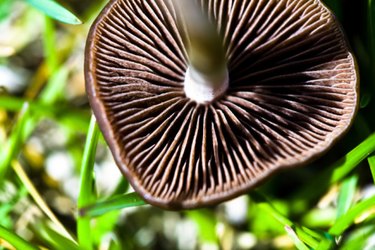
In some ways, mushroom spores are similar to pollen in flowers, as spores are essential to mushroom reproduction and propagation. If a mushroom doesn't produce spores, it can't reproduce and spread, which is vital to the life of the species. It is interesting to learn how spores work and how mushroom spores grow new mushrooms.
What Do Mushroom Spores Do?
Video of the Day
What are spores? Spores are single-cell organisms that contain all the genetic material necessary for the species of mushrooms to spread. The scientific spore definition states that mushrooms are an above-ground fruiting body primarily identified by their shafts and stems. Spores are located in the pores, teeth or grooves of the underside of the mushroom cap.
Video of the Day
Mushrooms don't always produce spores, though. There have to be enough resources, including food, water and light, for the plant to have the energy to reproduce. If the circumstances are favorable, it will produce spores.
Spores are far too tiny for the naked eye to see, but when a mushroom spore is ready, it drops or is propelled from the mushroom cap. Because it's so small, it can be easily carried by animals or wind. Most spores will fall on barren ground, but enough will fall somewhere conducive to life. Those spores send out shoots that connect with shoots from spores from other mushrooms, allowing a new one to grow.
The Other Parts of a Mushroom
A mushroom's spores are produced in the cap, but that's just one part of the mushroom, a fascinating organism. They are composed of at least four essential components. The first is mycelium, which is similar to roots. Mycelium can live underground for long periods, growing new fruiting bodies. The next is hyphae, also similar to roots. These are larger and grow closer to the stem and the volva, which is the thick membrane at the base of the mushroom.
The fruiting body contains the cap and gills, where the spores are produced. The cap can be flat, round or conical. The gills come in a range of shapes and colors as well.
All parts of the mushroom are essential to its survival. The mycelium and hyphae absorb water and nutrients from the soil. The fruiting body creates spores for reproduction and helps make food. The stem draws essentials up to the body and supports the entire plant.
How to Identify Mushrooms
In total, there are over 14,000 types of mushrooms in the world. You can identify them using spores. If you gather wild mushrooms, put the caps on a blank sheet of white paper and cover them with a bowl. Leave them for 24 hours, then inspect the color, shape, and other characteristics of the spores on the paper. Use that to determine your mushroom type. Analyzing the gills is also a good way to identify the type of mushroom.
While some species of mushrooms are highly nutritious to humans, others are poisonous, even deadly. Psilocybin spores produce the legendary "magic mushrooms" that induce hallucinations and feelings of euphoria in human users.